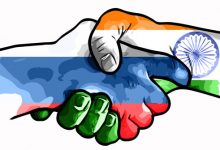 Have you ever wondered what it would be like to be the last of your species? To wander ceaselessly across land, water, sky in search of another like you and to find nothing but illusions. Radhika tells us about the vanishing species, in the weekly column, exclusively in Different Truths.
Have you ever wondered what it would be like to be the last of your species? To wander ceaselessly across land, water, sky in search of another like you and to find nothing but illusions. Radhika tells us about the vanishing species, in the weekly column, exclusively in Different Truths.
There are few stories which have left an impact on my heart as a child, as has The Fog Horn, a 1951 science fiction short story by American Writer Ray Bradbury. The story takes place in a remote lighthouse and tells the tale of a lonesome and anguished sea creature drawn to the light and the sound of the foghorn of the lighthouse. The story forces us to look at our own darkness and the fate we are subjecting onto countless species on our planet.
In the story, two men work in the lighthouse and as the fog horn of their lighthouse mournfully calls out one misty night, the older employee, MacDunn talks about a sea creature which visited the light house every year, heeding the call of the fog horn. In the story, the fog horn has a sound unlike any other, a sound like the sea, one that reminds us of the emptiness of a house once everyone has left, of one’s countless thoughts restlessly seeking willing ears but finding none, of an empty bed, of a cold rainy night. That night, yet again, the fog horn summoned with its mournful call the ancient sea creature, calling back to the lighthouse as if it was its last hope and love.
The Fog Horn blew. An answering cry came across a million years of water and mist. A cry so sad and lonely. The Fog Horn blew. And the monster answered. The Fog Horn blew. The monster opened its great mouth and the sound that came from it was the sound of the Fog Horn itself. Lonely and vast and far away. The sound of isolation. That was the sound.

“Imagine, all year-long,” whispered MacDunn, ‘that poor monster waits, deep in the sea. Maybe it’s the last of its kind. Think of it, waiting a million years!”
The fog horn is turned off briefly; the monster finding no response to its calls destroys the lighthouse in a fit of despair fueled rage. Fortunately, the two men escape alive. But the monster is never seen again.
Have you ever wondered what it would be like to be the last of your species? To wander ceaselessly across land, water, sky in search of another like you and to find nothing but illusions.
On June 17, 1987, the last Dusky Seaside sparrow died despite many efforts by conservationists to save its last habitat and surviving individual.
In 1983, the last four living dusky seaside sparrows were taken for conservation breeding to a protected habitat on the Discovery Island nature reserve in Florida. By March 31, 1986, only one individual “Orange Band” remained. Despite being blind in one eye, Orange Band reached extreme old age for a sparrow, possibly having lived to thirteen years old, before dying in captivity on June 17, 1987. A Washington Post headline read “Goodbye forever, dusky seaside sparrow” Author Robert James Waller wrote eloquently about the death of the last Dusky Seaside Sparrow in “My name is Orange Band.” Orange Band, blind in one eye, old and alone, was gone. But the day Orange Band died there was a faint sound out there in the universe, hardly noticeable unless you were expecting it and listening. It was a small cry, the last one, that arched upward from a cage in Florida.
The Orlando Sentinel wrote, “Like the canary who warns miners that oxygen was low, the extinction of the Dusky seaside sparrow sends a message to us, “we are all in peril”.
In 2011, the last Western Black rhinoceros and the Vietnamese Javan rhino were declared extinct by the IUCN . The gunshots of the poachers rang through the forest until the last ones were killed. The Bali tiger, Caspian tiger and Javan tiger share the same fate.
The Dream of the Thylacine is a book by Margaret Wild and Ron Brooks which talks about the Tasmanian tiger. The book brings a narrative imagining the voice of the last known thylacine, which died in captivity in the late 1930s, with two visual narratives. One is of the thylacine in the wild as it dreams of its former life as part of the natural world. The other is an unsettling account of the individual in captivity with wood walls and wire fencing. A narrative from the book reads as follows.
Trapped am I,
in cage of twisty wire, cold concrete.
PROWL
RAGE
HOWL
Know you not that I am tooth and claw–
see me hunt through bracken and bush,
see me swagger across wild lands,
see me glory at the edge of cliff.
In 2016, WWF and reported in its Living Planet report that Earth has lost an average 58% of its wildlife populations, sin ce 1970. However, worse is to come as climate change and habitat loss are leading us into the Sixth Mass Extinction.
ce 1970. However, worse is to come as climate change and habitat loss are leading us into the Sixth Mass Extinction.
Did we even get a chance to bid farewell to these wonderful species? We have no rituals for coping with extinction, ecological destruction or environmental loss. Did we stop and think about the societal systems that prevent us seeing clearly the extent of the ecological, social and cultural disintegration? The fragility of life lies hidden behind the patterns of ordinary life. There is a false sense of safety in these patterns. So long as it repeats, we continue on as if all the things we count on or take for granted will still be there.
We must resist being slaves to complacency and instead explore the stories of species, cultures, life-ways and habitats driven extinct by unjust power structures and exploitation, past and present.
For now, I bid adieu to all the lost ones, the last ones. Goodbye forever Steller’s sea cow, Great Auk, Passenger pigeon, Carribean monk seal, Dodo, Baiji White Dolphin, Bali Tiger…
©Radhika Bhagat
Photos sourced by the author from the Internet
#Environment #Species #cultures #Lifeways #Extinction #SpiritualEcology #DifferentTruths





 By
By
 By
By

 By
By
Well written.If only we human can understand how badly we ruining the planet.and that we creating our own hell on beautiful earth.the article touched my soul .bcz i feel closer to animals n hv studied zoology.its a pity that we as human think we are only one who can live on the planet..ignoring the fact that we are just part of a food web.n every single species of flora n fauna is important to maintain the balance .
What a lovely article! Well done Radhika